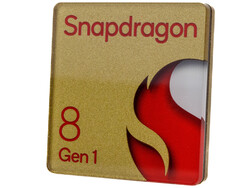First benchmarks: This is how fast the new Snapdragon 8 Gen 1 is
As part of its Snapdragon Tech Summit, Qualcomm presented the Snapdragon 8 Gen 1, its new premier SoC for Android-based smartphones and tablets, among other things. The system on a chip (SoC) is Qualcomm's first manufactured on a 4 nm process and is also based on ARM's v9 architecture. Above all, these changes promise higher efficiency compared to the Snapdragon 888. However, since the processor's clock speeds have hardly changed between generations, you should expect only minor speed advantages in this area. The situation is different with the Graphics Processing Unit (GPU) though, the architecture of which has been fundamentally revised. The Snapdragon 8 Gen is the first SoC with an Adreno GPU from the new 700 series, as well.
Qualcomm has also extensively improved image processors on which a smartphone's cameras rely. Qualcomm's image processors now work at 18-bits, for reference. Additionally, Qualcomm has integrated another energy-saving Image Signal Processor (ISP) within its sensing hub. This is now permanently active too, and opening up new possibilities in the process. Also, Qualcomm has equipped the Hexagon chipset with a tensor unit that is twice as large as it was previously, which offers four times the performance for machine learning and AI algorithms compared to the one in the Snapdragon 888.
While Snapdragon 8 Gen 1-powered devices are yet to hit the shelves, we were able to carry out initial benchmarks with a reference design at Qualcomm's on-site summit. The reference design has a Full HD+ display (AMOLED) with a 144 Hz refresh rate and 8 GB of LPDDR5 RAM, along with 512 GB of UFS 3.1 internal storage.
Specifications
| Snapdragon 8 Gen 1 | Snapdragon 888+ | Snapdragon 888 | |
|---|---|---|---|
| Architecture | 4 nm (Samsung EUV), ARMv9-based | 5 nm (Samsung EUV), ARMv8.4A-based | 5 nm (Samsung EUV), ARMv8.4A-based |
| CPU | 1x Cortex X2 (up to 3.0 GHz)3x Cortex A710 (up to 2.5 GHz) 4x Cortex A510 (up to 1.8 GHz) | 1x Cortex X1 (up to 3.0 GHz)3x Cortex A78 (up to 2.42 GHz) 4x Cortex A55 (up to 1.8 GHz) | 1x Cortex X1 (up to 2.84 GHz)3x Cortex A78 (up to 2.42 GHz) 4x Cortex A55 (up to 1.8 GHz) |
| GPU | Adreno 730 | Adreno 660 | Adreno 660 |
| 5G modem | Snapdragon X65Download: up to 10.0 GBit/sUpload: up to 3 GBit/s | Snapdragon X60Download: up to 7.5 GBit/sUpload: up to 3 GBit/s | Snapdragon X60Download: up to 7.5 GBit/sUpload: up to 3 GBit/s |
| ISP | Triple 18-bitAlways-On ISP in the sensor hub | Triple 14-bit | Triple 14-bt |
Benchmarks - Snapdragon 8 Gen 1 with a strong plus for GPU and AI
The central processor unit of the Qualcomm Snapdragon 8 Gen 1 is manufactured in a more modern manufacturing process and is based on the current Cortex designs from ARM. Qualcomm divides the central processing unit into three clusters, but each cluster hardly offers improved clock speeds compared to the Snapdragon 888 and Snapdragon 888+.
While the prime core works unchanged at 3.0 GHz compared to the Snapdragon 888+, the frequencies of the three performance cores (Cortex A710) have been increased slightly to 2.5 GHz. By contrast, the equivalent cores in the Snapdragon 888 and Snapdragon 888+ work at 2.42 GHz. The four energy-saving cores (Cortex A510) work again at up to 1.8 GHz each.
Correspondingly, the performance increase in Geekbench is low. Single-core performance increases by around 10 per cent, but it does not come close to the iPhone 13 Pro with Apple's A15 Bionic SoC. In Geekbench's multi-core test, the increase was even slightly lower compared to the Snapdragon 888 and Snapdragon 888+.
The situation is different in the AnTuTu 9, which also only achieves an improvement of 10 per cent in the CPU benchmark. However, the Snapdragon 8 Gen 1 is 7 per cent faster than the iPhone 13 Pro in this benchmark.
| Geekbench 5.5 | |
| Single-Core | |
| Apple iPhone 13 Pro | |
| Qualcomm Snapdragon 8 Gen 1 Reference | |
| Nubia RedMagic 6S Pro | |
| Asus ROG Phone 5s | |
| Xiaomi Mix 4 | |
| Samsung Galaxy S21 Ultra | |
| Google Pixel 6 | |
| Multi-Core | |
| Apple iPhone 13 Pro | |
| Qualcomm Snapdragon 8 Gen 1 Reference | |
| Asus ROG Phone 5s | |
| Nubia RedMagic 6S Pro | |
| Xiaomi Mix 4 | |
| Samsung Galaxy S21 Ultra | |
| Google Pixel 6 | |
| Antutu v9 - CPU | |
| Qualcomm Snapdragon 8 Gen 1 Reference | |
| Apple iPhone 13 Pro | |
| Xiaomi Mix 4 | |
| Samsung Galaxy S21 Ultra | |
| Google Pixel 6 | |
The new Adreno 730 GPU shows itself to be extremely strong, demonstrating enormous improvements when interacting with the Vulkan API, in particular. In the current 3DMark Wild Life (Extreme), the Snapdragon 8 Gen 1 achieves 77 per cent or 68 per cent higher scores than its predecessor. Only the iPhone 13 Pro is faster than the Snapdragon 8 Gen 1 in this benchmark, but it also uses the in-house metal interface. If we use the older OpenGL ES, Apple's chipset can no longer keep up, putting the Snapdragon 8 clearly out on top. Switching to this API demonstrates relatively small increases in the total score. It is a different story again when assessing a pure graphic calculation though, where the Snapdragon 8 Gen 1 enjoys at least a 50 per cent lead over its rivals.
The Adreno 730 in the Snapdragon 8 Gen 1 is dominant in GFXBench too, in which it even outperforms Apple's A15 Bionic in every test. Similarly, the Snapdragon 8 Gen 1 offers almost double its performance compared to its predecessor SoC. Using the Vulkan API, the Snapdragon 8 Gen 1 SoC can still achieve a few more frames than its competitors. This is an excellent thing in itself, but Qualcomm claims that 95 per cent of all games still utilise the OpenGL ES API.
| GFXBench (DX / GLBenchmark) 2.7 - 1920x1080 T-Rex Offscreen | |
| Qualcomm Snapdragon 8 Gen 1 Reference | |
| Apple iPhone 13 Pro | |
| Xiaomi Mix 4 | |
| Nubia RedMagic 6S Pro | |
| Samsung Galaxy S21 Ultra | |
| Google Pixel 6 | |
| GFXBench 3.0 - 1920x1080 1080p Manhattan Offscreen | |
| Qualcomm Snapdragon 8 Gen 1 Reference | |
| Apple iPhone 13 Pro | |
| Xiaomi Mix 4 | |
| Nubia RedMagic 6S Pro | |
| Samsung Galaxy S21 Ultra | |
| Google Pixel 6 | |
| GFXBench 3.1 - 1920x1080 Manhattan ES 3.1 Offscreen | |
| Qualcomm Snapdragon 8 Gen 1 Reference | |
| Apple iPhone 13 Pro | |
| Nubia RedMagic 6S Pro | |
| Xiaomi Mix 4 | |
| Samsung Galaxy S21 Ultra | |
| Google Pixel 6 | |
| GFXBench | |
| 1920x1080 Car Chase Offscreen | |
| Qualcomm Snapdragon 8 Gen 1 Reference | |
| Apple iPhone 13 Pro | |
| Samsung Galaxy S21 Ultra | |
| Xiaomi Mix 4 | |
| Nubia RedMagic 6S Pro | |
| Google Pixel 6 | |
| 1920x1080 Aztec Ruins Normal Tier Offscreen | |
| Qualcomm Snapdragon 8 Gen 1 Reference | |
| Qualcomm Snapdragon 8 Gen 1 Reference | |
| Apple iPhone 13 Pro | |
| Asus ROG Phone 5s | |
| Samsung Galaxy S21 Ultra | |
| Xiaomi Mix 4 | |
| Nubia RedMagic 6S Pro | |
| Google Pixel 6 | |
| 2560x1440 Aztec Ruins High Tier Offscreen | |
| Qualcomm Snapdragon 8 Gen 1 Reference | |
| Qualcomm Snapdragon 8 Gen 1 Reference | |
| Apple iPhone 13 Pro | |
| Asus ROG Phone 5s | |
| Samsung Galaxy S21 Ultra | |
| Xiaomi Mix 4 | |
| Google Pixel 6 | |
| Nubia RedMagic 6S Pro | |
Since the system speed does not only depend on the SoC, the values in PCMark indeed leave a lot of room. However, they are already relatively high in Android 12, installed on the reference design. It is also worth mentioning that the AnTuTu score reaches seven digits for the first time.
The AImark only covers a particular part of the performance for machine learning and AI algorithms. Here, the Snapdragon 8 Gen 1 lags behind its predecessor and must admit defeat to Apple and Samsung's Exynos 2100.
We would not recommend overestimating these scores though, because AImark is yet to be optimised for the Snapdragon 8 Gen 1. We expect to see significantly higher scores when the first final devices arrive.
| AImark - Score v2.x | |
| Xiaomi Mi 11i | |
| Samsung Galaxy S21 Ultra | |
| Apple iPhone 13 Pro | |
| Qualcomm Snapdragon 8 Gen 1 Reference | |
| Xiaomi Mix 4 | |
| Nubia RedMagic 6S Pro | |
| Google Pixel 6 | |
| Antutu v9 | |
| Total Score | |
| Qualcomm Snapdragon 8 Gen 1 Reference | |
| Xiaomi Mix 4 | |
| Apple iPhone 13 Pro | |
| Xiaomi Mi 11i | |
| Samsung Galaxy S21 Ultra | |
| Google Pixel 6 | |
| CPU | |
| Qualcomm Snapdragon 8 Gen 1 Reference | |
| Apple iPhone 13 Pro | |
| Xiaomi Mix 4 | |
| Xiaomi Mi 11i | |
| Samsung Galaxy S21 Ultra | |
| Google Pixel 6 | |
| GPU | |
| Qualcomm Snapdragon 8 Gen 1 Reference | |
| Xiaomi Mix 4 | |
| Xiaomi Mi 11i | |
| Apple iPhone 13 Pro | |
| Samsung Galaxy S21 Ultra | |
| Google Pixel 6 | |
| MEM | |
| Qualcomm Snapdragon 8 Gen 1 Reference | |
| Apple iPhone 13 Pro | |
| Xiaomi Mix 4 | |
| Samsung Galaxy S21 Ultra | |
| Xiaomi Mi 11i | |
| Google Pixel 6 | |
| UX | |
| Qualcomm Snapdragon 8 Gen 1 Reference | |
| Xiaomi Mix 4 | |
| Xiaomi Mi 11i | |
| Google Pixel 6 | |
| Samsung Galaxy S21 Ultra | |
| Apple iPhone 13 Pro | |
| PCMark for Android - Work 3.0 | |
| Qualcomm Snapdragon 8 Gen 1 Reference | |
| Asus ROG Phone 5s | |
| Xiaomi Mi 11i | |
| Samsung Galaxy S21 Ultra | |
| Xiaomi Mix 4 | |
| Nubia RedMagic 6S Pro | |
| Google Pixel 6 | |
The memory connection has been improved, especially in terms of write speeds. Additionally, the Snapdragon 8 Gen 1 delivers significant improvements when writing small data blocks compared to the Snapdragon 888 and Snapdragon 888+.
| Qualcomm Snapdragon 8 Gen 1 Reference Adreno 730, SD 8 Gen 1, 512 GB UFS 3.1 Flash | Asus ROG Phone 5s Adreno 660, SD 888+ 5G, 512 GB UFS 3.1 Flash | Xiaomi Mix 4 Adreno 660, SD 888+ 5G, 512 GB UFS 3.1 Flash | Nubia RedMagic 6S Pro Adreno 660, SD 888+ 5G, 128 GB UFS 3.1 Flash | Google Pixel 6 Mali-G78 MP20, Tensor, 128 GB UFS 3.1 Flash | Samsung Galaxy S21 Ultra Mali-G78 MP14, Exynos 2100 5G, 128 GB UFS 3.1 Flash | |
|---|---|---|---|---|---|---|
| AndroBench 3-5 | ||||||
| Sequential Read 256KB (MB/s) | 1866 | 1972 | 1938 | 1607 | 1546 | 1710 |
| Sequential Write 256KB (MB/s) | 1275 | 770 | 751 | 765 | 233.4 | 1077 |
| Random Read 4KB (MB/s) | 302.9 | 297.8 | 242.1 | 285.8 | 126.2 | 316.7 |
| Random Write 4KB (MB/s) | 412.7 | 287.2 | 284.2 | 254.9 | 190.3 | 279.5 |
Stress test - Long term performance is on par with Apple's A15 Bionic
High performance usually creates a lot of heat, a problem that many manufacturers have not gotten to grips with the Snapdragon 888 and Snapdragon 888+. Even the Snapdragon 8 Gen 1 reference design is not immune to this, as our 3DMark Wild Life Unlimited stress test results below demonstrate.
The new Snapdragon SoC reaches its lowest point by its seventh run, losing around a quarter of its initial performance. Still, it remains around 50 per cent faster than its predecessor with good cooling. Incidentally, the Apple A15 Bionic drops to the Snapdragon 8 Gen 1's level from the fourteenth run, where the pair remain locked until they complete the test.
Therefore, the Snapdragon 8 Gen 1's long-term performance is equivalent to that of Apple. In saying that, the A15 Bionic only proves to be stronger in terms of peak performance.
Wild Life Unlimited stress test
Conclusion - A successful evolution
As expected, the Qualcomm Snapdragon 8 Gen 1 improves in all areas over its predecessors. The CPU gains are not particularly big, but the situation is different with the Adreno 730. The new GPU is at least on par in most areas with Apple's seemingly formidable competition.
The Snapdragon 8 Gen 1 offers some significant innovations. We are curious to see which ones will be exhausted when flagship smartphones arrive in 2022.
The first benchmark results for the AI performance are a little sobering and even lag behind those of the Snapdragon 8 Gen 1's predecessor. However, we expect better results with final devices. Nevertheless, Qualcomm's insistence that the Snapdragon 8 Gen 1 offers the best AI performance per watt implies that the SoC will not turn out to be a high-flyer in this regard. In short, the manufacturer wants to be more efficient than offering the highest acceleration, which will be a battery-saving decision. This is particularly apparent with a view to the Always-On-IPS and the Always-On-AI.
The new ISPs also promise better photos and videos in 8K HDR. There are only a few innovations regarding connectivity, but the Snapdragon 8 Gen 1 does not fall short in this area. This is a plus point, in our opinion, especially with the MediaTek Dimensity 9000 on the horizon, which should not be underestimated.








